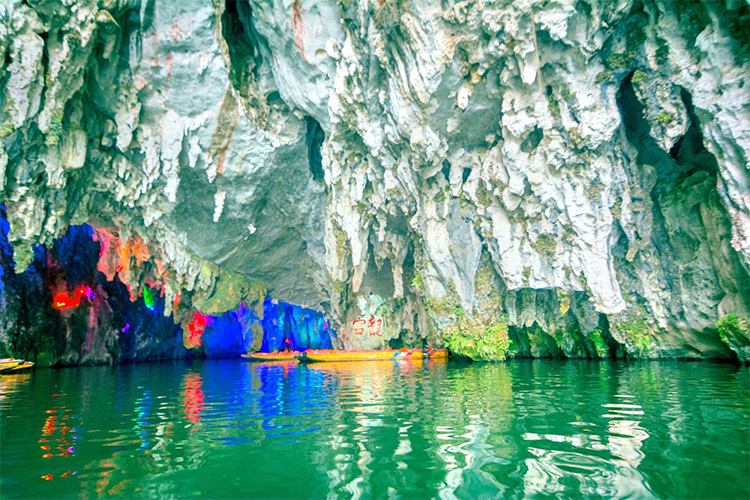Explore Dragon Palace Cave: China’s Spectacular Underground River Cave
Introduction:
When your oar breaks the dark water and stalactites morph in the beam of light into dragons, palaces and mythical beasts, you will feel as if you are floating on the planet’s pulse. Dragon Palace Scenic Area (Longgong) in Anshun, Guizhou, is an underground kingdom sculpted by karst forces over millions of years. With the country’s longest and most spectacular navigable water cave, it’s often called “China’s King of Caves.” Glide a small boat through an underground river maze, watch waterfalls pour from cavern ceilings like inverted galaxies, see whirlpools spin in natural Taiji patterns, then step out to Buyi villages to hear mountain songs—this site is both a geology textbook and a sensory, immersive adventure.
1. Soul Interpretation: A Karst Masterpiece
“One cave contains the world; the underground river carries millennia.” Dragon Palace uses a five-kilometer underground river and cave complex to showcase karst’s awe-inspiring artistry. As a World Geopark and national scenic area, its core values are embodied in three unique features:
– Longest navigable water cave: The only cave in China where visitors can travel the whole scenic sequence by boat. The underground river links the five main “entrances” of Dragon Palace, like walking through the mythic corridors of ancient Chinese lore.
– Dynamic geological spectacles: The Dragon Gate Waterfall is the largest cave waterfall in China, thundering like a storm. Natural whirlpools rotate in the pools, suggesting Taoist yin-yang balance.
– Living cultural layer: Outside the cave, Buyi and Miao villages blend farming, rituals and nature worship with the landscape, offering a living example of human-land co-existence.
2. An Epic Carved by Time
Stalactites here grow roughly 1 cm every 100 years; formations such as the “Dragon King Pagoda” and the “Coral Wall” have quietly grown for hundreds of thousands of years. Science lovers will be captivated by the details:
– A karst encyclopedia: Stalagmites, draperies, helictites, cave pearls—Dragon Palace contains nearly every microform of karst. Some flowstones are rare blue hues due to mineral content.
– The underground river mystery: The subterranean water meets national first-class standards—crystal clear. Boats often float past cave-adapted creatures such as blind fish and transparent shrimp, like a primeval Jurassic beneath the earth.
– Human traces: Ming dynasty traveler Xu Xiake recorded this region with wonder in his travel diaries, noting the rivers that emerge from caves without obvious sources.

3. Seasonal Wonders: When to Visit Dragon Palace
– Peak season (April–October): Water levels are higher, waterfalls more powerful, and the cave’s stable 18°C makes it a perfect summer escape. After summer rains, whirlpool rotation speeds up and the spectacle intensifies.
– Autumn and winter (November–March): Fewer visitors and a quieter, deeper cave atmosphere, though some channels may close during low-water periods. Light mists on the surrounding mountains create ink-wash landscapes, favored by photographers.
Tip:
9:00–11:00 each morning is the best light window. When sunlight slants into the cave mouth and hits the Dragon Gate Waterfall, you can capture dramatic rainbow-through-waterfall photos.
4. Adventure Guide: From Easy Visits to Deeper Exploration
Classic half-day route:
Park entrance → boat ride through the first chamber of Dragon Palace (approx. 40 minutes) → walk to view the Dragon Gate Waterfall → whirlpool viewing platform → return. Ideal for families and visitors short on time.
Full-day deep experience:
Add hiking into the second and third chambers (some passages require bending), explore smaller features like the Sky Pool and Tiger Cave, and finish by visiting Longtan Buyi Village to try indigo dyeing and sample glutinous rice wine.
Special group tips:
– Seniors & children: Stick to the boat sections; avoid long hiking segments. The site includes many steps—wear non-slip shoes.
– Photographers: Bring a compact tripod (notify staff in advance) and high-ISO lenses for dim passages.

5. Practical Information: Getting There and Services
– How to reach:
– From Guiyang: About 1.5 hours by car (Hukun Expressway, Anshun West exit), or take a high-speed train to Anshun West Station (approx. 30 minutes) and transfer to the scenic-area shuttle (about 40 minutes).
– From Anshun city center: Bus No. 19 direct to the park, about 50 minutes.
– Tickets and reservations:
– Full ticket: RMB 150 (includes boat ride). Book at least one day in advance via the “One-Code Travel Guizhou” reservation system. Consider the combined geopark ticket that includes Huangguoshu for savings.
– Language services:
– Signs are bilingual (Chinese/English). English-speaking guided tours can be booked with 48 hours’ notice.
6. Beat the Crowds: Offbeat Tips and Hidden Gems
– Morning advantage: Arrive by 8:30 to be among the first visitors and enjoy a nearly empty, ethereal cave. Mid-afternoon (after 2:00 pm) is when tour groups peak—avoid that window if you prefer solitude.
– Secret finds: Behind the scenic area are dozens of sinkholes and “drain” depressions—a hidden checklist for geology enthusiasts.
– Overnight options: Stay at local Buyi guesthouses near the exit (for example Longtan Inn). Nighttime bonfires and performances often include ancient songs like “Origin of the Dragon Palace.”

Finale: Let the Underground Myth Become Real
Dragon Palace blurs the line between nature and myth—touch formations still growing and you might hear the earth’s heartbeat. Whether you are a geologist, cultural traveler, or an adventurer seeking to escape the ordinary, there is a secret chamber here just for you. Now is the time to descend into Guizhou’s heart and witness a performance millions of years in the making.


